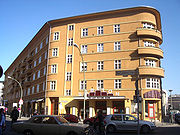
Rosa-Luxemburg-Platz
Encyclopedia


Germany
Germany , officially the Federal Republic of Germany , is a federal parliamentary republic in Europe. The country consists of 16 states while the capital and largest city is Berlin. Germany covers an area of 357,021 km2 and has a largely temperate seasonal climate...
.
The square is dominated by the Volksbühne
Volksbühne
The Volksbühne is a theater in Berlin, Germany. Located in Berlin's city center Mitte on Rosa-Luxemburg-Platz in what was the GDR's capital....
and by the Karl-Liebknecht-Haus
Karl-Liebknecht-Haus
The Karl-Liebknecht-Haus or Karl Liebknecht House is the headquarters of the Party The Left in Germany. It is located between the Alexanderplatz and Rosa-Luxemburg-Platz in Berlin-Mitte....
, the headquarters of the German Left Party
Left Party (Germany)
The Party of Democratic Socialism was a democratic socialist political party active in Germany from 1989 to 2007. It was the legal successor to the Socialist Unity Party , which ruled the German Democratic Republic until 1990. From 1990 through to 2005, the PDS had been seen as the left-wing...
. The party's predecessor, the Communist Party of Germany
Communist Party of Germany
The Communist Party of Germany was a major political party in Germany between 1918 and 1933, and a minor party in West Germany in the postwar period until it was banned in 1956...
, opened its headquarters on the square in 1926.
The square was previously named Babelsberger Platz (1907-1910) and Bülowplatz (1910-1933). In 1933, with the rise of the Third Reich, it was renamed Horst-Wessel-Platz (1933-1945) after National Socialist
Nazism
Nazism, the common short form name of National Socialism was the ideology and practice of the Nazi Party and of Nazi Germany...
martyr
Martyr
A martyr is somebody who suffers persecution and death for refusing to renounce, or accept, a belief or cause, usually religious.-Meaning:...
Horst Wessel
Horst Wessel
Horst Ludwig Wessel was a German Nazi activist who was made a posthumous hero of the Nazi movement following his violent death in 1930...
. Following the fall of Berlin and Soviet occupation, the square, then part of communist-controlled East Berlin
East Berlin
East Berlin was the name given to the eastern part of Berlin between 1949 and 1990. It consisted of the Soviet sector of Berlin that was established in 1945. The American, British and French sectors became West Berlin, a part strongly associated with West Germany but a free city...
, was renamed Liebknechtplatz (1945-1947) after German communist Karl Liebknecht
Karl Liebknecht
was a German socialist and a co-founder with Rosa Luxemburg of the Spartacist League and the Communist Party of Germany. He is best known for his opposition to World War I in the Reichstag and his role in the Spartacist uprising of 1919...
. It was then renamed Luxemburgplatz (1947-1969) after communist leader Rosa Luxemburg
Rosa Luxemburg
Rosa Luxemburg was a Marxist theorist, philosopher, economist and activist of Polish Jewish descent who became a naturalized German citizen...
, until it was given the name Rosa-Luxemburg-Platz by the SED regime
Socialist Unity Party of Germany
The Socialist Unity Party of Germany was the governing party of the German Democratic Republic from its formation on 7 October 1949 until the elections of March 1990. The SED was a communist political party with a Marxist-Leninist ideology...
in 1969.
The square is noted as the scene of the murders of Paul Anlauf and Franz Lenck
Murders of Paul Anlauf and Franz Lenck
The Murders of Paul Anlauf and Franz Lenck were a double homicide that took place in Berlin in 1931, when police captains Paul Anlauf and Franz Lenck were assassinated by members of the Communist Party of Germany.-Planning and execution:...
, police captains who were the victims of a double homicide in 1931 at the hands of members of the Communist Party of Germany
Communist Party of Germany
The Communist Party of Germany was a major political party in Germany between 1918 and 1933, and a minor party in West Germany in the postwar period until it was banned in 1956...
. A monument created by Hans Dammann commemorating Anlauf and Lenck was erected in the square in 1934, but was destroyed in 1950 by Erich Mielke
Erich Mielke
Erich Fritz Emil Mielke was a German communist politician and Minister of State Security—and as such head of the Stasi —of the German Democratic Republic between 1957 and 1989. Mielke spent more than a decade as an operative of the NKVD during the rule of Joseph Stalin...
, one of the murderers, who was by then a powerful man in East Germany.

